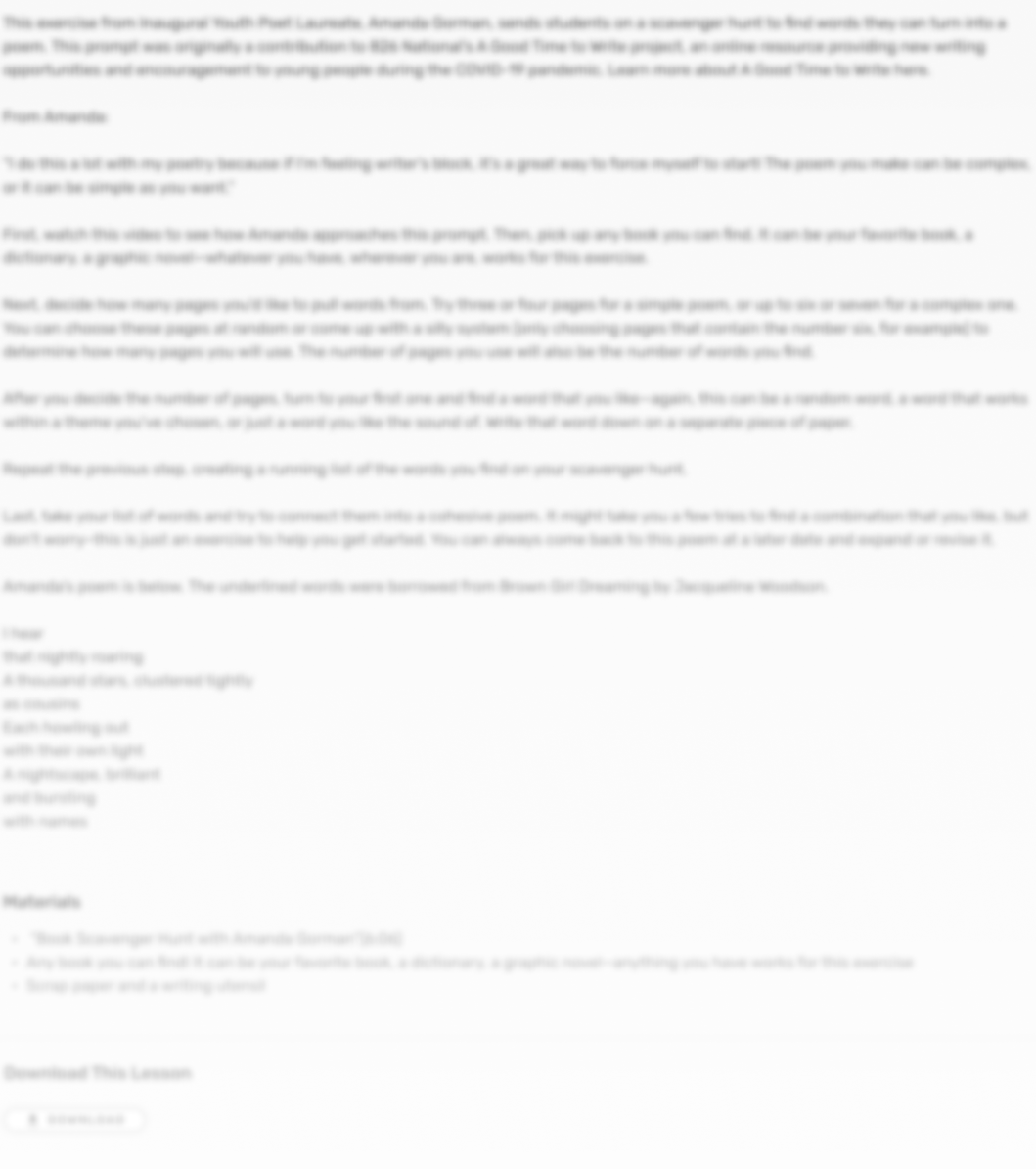 Grades 1–5
Grades 1–5 Narrative, Poetry
Narrative, Poetry Sparks
SparksYour students will practice connecting the five senses to their favorite things or experiences.
Students will produce a personal anchor chart they can return to in the future for ideas.
Sensory mapping can be a useful tool for sparking authentic writing in any genre. This Spark is inspired by Georgia Heard’s Heart Mapping activity, which can be found in Awakening the Heart: Exploring Poetry in Elementary and Middle School.
First, pass out Page 1 of the Sensory Heart Mapping — Handout so students can brainstorm their favorite sights, sounds, etc.
Adaptation Notes: Younger writers can draw simple pictures, instead of writing. English Language Learners can also be encouraged to use their home language.
After students have finished brainstorming, they can use Page 2 of the “Sensory Heart Mapping—Handout” to complete their map. Encourage students to get creative when designing their maps. They can use colored pencils or markers to color-code their memories—or, maybe your students associate their senses with shapes! Students will also create a map key, so however they want to represent themselves on their map...

by Molly Sprayregen, 826CHI
In this social-emotional learning writing prompt, students help their new friend Olly the Octopus overcome his feelings of overwhelm by writing about strategies that work for them.
by Asia Calcagno, 826CHI
Writing can be a powerful tool when working through feelings of grief, sadness, or anger. This Spark creates an intentional opportunity for youth to write and speak about what is on their minds.
by 826 National and Cartoon Network
Students are inspired to write about a time that they felt accepted and appreciated for who they are.
by 826 National and Cartoon Network
Students write similes to express what their emotions feel like and build plans to treat others with kindness and empathy.
by the Team at 826CHI
Students learn to incorporate setting as a key element of a story, starting with inspiration from collages.
by Molly Sprayregen, 826CHI
In this collection of poetry activities, young writers will explore a range of feelings and strengthen their emotional vocabulary. Activities are available in print and web versions!
by Molly Sprayregen, 826CHI
In this social-emotional learning writing prompt, students create a poem that shares the "happys" in their life.
by author Daniel Handler, a.k.a. Lemony Snicket
Students will anthropomorphize an inanimate object to produce interview questions and answers.
by Mindy Misener, 826michigan
This activity encourages young writers to identify the rules in their own poems and to then experience the joy of either smashing the rules outright or finding a graceful way to reimagine them.
by 826 National, inspired by Julianna Lee Mariano, 826NYC
Calling all ghostbusters! In this Spark, students will learn more about what makes a spooky story and then develop their own creepy characters, with a silly twist.
by Bryan Wilson, Educator Leader, Bureau of Fearless Ideas
In this lesson students will work together to revise a scene from a first draft by adding descriptive details.
by Molly Sprayregen, 826CHI
In this social-emotional learning writing prompt, students reflect on the sound of feelings and use onomatopoeias in their poetry.
by 826 New Orleans
Students will imagine what they would do if they were someone or something else.
by 826 National
The Character-O-Matic is a writing tool that helps students to create new characters. In this lesson, students will use it to create a character profile that reflects their own identies.
by Jane Roschen, 826LA
In this activity, students will explore superhero traits or superpowers that they know or admire. What kind of jobs do they do? How do their powers help them achieve this?
by 826 National, in partnership with Academy of American Poets
In this Spark, students will explore the many ways you can connect to a poem.
by Ashlyn Anstee, 826LA
Students will be asked to take an existing 4-panel comic and create their own dialogue. This is a fun quick activity or warm-up exercise that will challenge students to write efficiently.
by 826 National
This summer is all about writing for fun! In this Spark, you’ll find a BINGO board full of engaging writing prompts to keep skills sharp over the summer break.
by 826 National
Engage young writers of any age at home with this collection of 826 Digital writing prompts and activities.
by Neil Gordon, 826LA
Students teach a "pirate" how to make a peanut butter and jelly sandwich and learn how to give effective instructions in the process.
by 826 National
In this Spark, students will write an acrostic poem that can be used as a tool to introduce themselves to their classmates.
by Mariama J. Lockington and Peter Calhoun Hall, 826NYC
In this Spark, students will write haikus from two different perspectives, one of a hero and one of an engineer, to design a secret lair for a superhero.
by 826 National
I Spy is a classic guessing game. In this Spark, students will play a game of I Spy to practice adding details to their writing.
by Mandy Seiner, 826NYC
Nouns, adjectives, verbs—and in this case—adverbs are the building blocks of super sentences. In this Spark, students will practice identifying and using adverbs in their writing.
by 826 National and Cartoon Network
Students reflect on what it feels like to stand up to bullying and write about a time when they used their voice to make a difference.
by Liz Levine, 826NYC
Challenge students to rewrite a classic nursery rhyme with a twist.
by Lauren Rudewicz and David Hutcheson, 826michigan
Students will define the word “ode” for themselves and identify the people and moments in their lives they’d like to celebrate in a poem.
by 826 National, inspired by student authors of 826 New Orleans
In this Spark, students will pretend to be their favorite food and write about what that food would do on an average day.
by Kiley McLaughlin & Dana Belott, 826 Valencia
Students experiment with alternative ways of writing poetry by reordering and rearranging pre-existing text.
by 826 National and Cartoon Network
In this twist on a classic game, students will practice intentional inclusivity with their classmates, as well as brainstorm other ways to continue building community throughout the school year.
by Aarti Monteiro, 826NYC
This activity explores the way emotions change how we perceive settings. Students work in groups to create descriptions of apartments based on an emotion they draw from a hat.
by Sarah Kokernot, 826CHI
Students use illustrations as entry points to write stories about friendship from a new perspective.
by 826 National
In this Spark, students will use backward thinking to create a four-panel comic strip story using the backward problem-solving skills of software developers.
by Paris Hyun, 826LA
Students will use creative thinking to innovate an imaginary elixir that targets a problem they see in the world.
by Ashley Houston-King, 826 Digital Educator Leader
Students will learn about representation, self-advocacy, and the work of Marley Dias before writing about this young advocate.
by Jillian Wasick, 826 Valencia
What are students made of? This activity prompts students to reimagine recipes and write about their life experiences.
by Daniel José Older, author of Flood City
This Spark introduces students to the fantastical world of Flood City and prompts them to write a journal entry from the perspective of a Flood City resident.
by the Team at 826CHI, with inspiration from Ryan Harty, 826michigan
In this activity, students practice analyzing a character’s internal motivations and fears and develop their own original characters.
by 826 National, inspired by student authors of 826 New Orleans
In this Spark, students will write a poem that engages the reader in answering the question: Can you guess this food?
by Julius Panoriñgan, 826LA
Students will use their knowledge of popular music to learn basic computer programming concepts.
by Nathalie Lagerfield, 826CHI
Students will imagine (and write about) their own fantastical worlds, using the cover illustrations of magazines as inspiration.
by the Team at 826CHI
In this activity, students create original monsters in archetypal protagonist and antagonistic roles by focusing on internal and external characteristics.
by Lindsay Stinson, 826LA
Students will learn to be empathetic towards those who are different by brainstorming scary characteristics of specific monsters and then developing more positive aspects to their nature.
by Julianna Lee Marino, 826NYC
In this Spark, students put on their detective hats and sleuth out places to add more details into their writing.
by Klariza Alvaran, 826CHI
This spark activity is designed to get your students on their feet while reinforcing the need for strong dialogue in narratives.
by 826 National
This activity reinforces the role of dialogue in a story, with students creating realistic conversation in A-Z fashion.
by 826 National
This Spark provides students with the opportunity to get to know their classmates by sharing personal stories about a specific topic.
by Andrea Nelson, 826DC
In this Spark, students will develop a setting that captures the environment of an alternate world.
by 826 National
With a little folding and loads of creativity, students make their own zines that feature abstract recipes.
by Pedro Estrada, 826LA
In this activity, students will examine narrative structure, explore the purpose and practice of myths, and put the two together to create their own original piece.
by 826 National
Students will write a poem about nature using sensory details to capture the sights, sounds, smells, tastes, and feeling of the subject.
by 826 National
By combining two classic games, students will learn how storytelling and art can build community or help them break through writer’s block.
by Cristeta Boarini, 826 MSP
Author bios offer students another opportunity to express themselves through writing and to feel like a real author. This Spark walks students through the process of writing one.
by Brittany Thierry, 826 New Orleans
In this Spark, students will write a diamante poem, using specific parts of speech to beautifully describe a topic of their choice.
by Kathy Seipp, 826 Digital Educator
Invite students to write freely with this lesson that includes directions for students to set up a writer's journal and favorite journal prompts.
by Mandy Seiner, 826NYC
Nouns, adjectives, adverbs—and in this case—verbs are the building blocks of super sentences. In this Spark, students share action words that bring them joy and incorporate those verbs into a story.
by 826 National, inspired by student authors of 826 New Orleans
We are all parts of a whole, just like a pizza! In this Spark, students will think about all the things that make them who they are and then write a poem in the shape of a pizza.
by 826 National and Cartoon Network
After writing about their personal and social identities, students discover that sometimes what makes us unique is what brings us together.
by 826 National, in partnership with Academy of American Poets
In this Spark, students will learn more about voice: what it is exactly, and how to name the elements of it.
by Nicolien Buholzer, 826LA
Why does kindness count? Students consider acts of kindness that they’ve experienced and reflect on the difference that kindness makes in the world.
by Molly Sprayregen, 826CHI
In this social-emotional learning writing prompt, students write a poem describing the silliest creature they can imagine.
by Rae Baum, 826 Digital Educator Leader
This quick writing prompt invites students to jump into the fantasy genre, imagining what happens when faced with the unexplainable!


We are thrilled to have you as the newest member of our online community. Stay up-to-date on the the latest and most relevant resources, student publication opportunities, and what’s new with the 826 Digital community.
